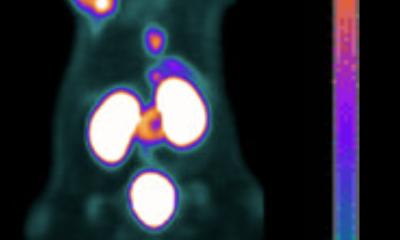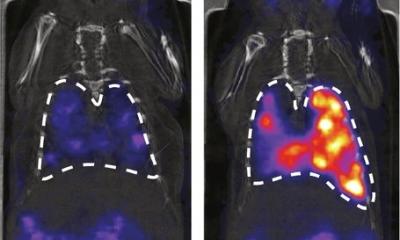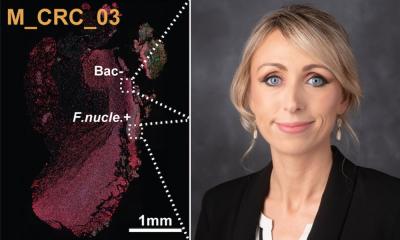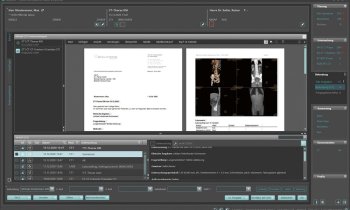
© ArtemisDiana – stock.adobe.com
News • Radiopharmaceutical study
New mini-protein shows promise in targeted radiation delivery to tumors
Researchers have shown for the first time that it is possible for a specially-designed ‘mini-protein’ to deliver a radiation dose directly to tumour cells expressing a protein on their cell surfaces called Nectin-4, which is often found in a number of different cancers.
In a study presented at the 36th EORTC-NCI-AACR Symposium on Molecular Targets and Cancer Therapeutics in Barcelona, Spain, Mike Sathekge, Professor and Head of the Nuclear Medicine Department at the University of Pretoria and Steve Biko Academic Hospital, South Africa, said he and his colleagues were able to show that the mini-protein, also known as a ‘radiopharmaceutical’, was able to target the cancer cells specifically, while avoiding healthy tissues, and that tumours in several different cancers absorbed the radiation dose. “This is the first time we are seeing a completely new technology used for targeted radiation. A small protein made to seek out a different protein that many cancers express, Nectin-4, was used to take radiation directly to the tumour,” he said.
The mini-protein is called AKY-1189 and is the first compound designed to deliver a therapeutic dose of Actinium-225, a radioactive element, by specifically targeting Nectin-4. This is a protein found in cell membranes and is over-expressed in up to 90% of patients with various solid tumours, including bladder, breast, lung, head and neck, cervical and bowel cancers. “We wanted to address the gap in care for patients whose cancer has grown beyond the part of the body it originated in or has spread to other parts of the body, and which had continued to progress on the local standard of care,” said Prof. Sathekge.
The researchers obtained permission for use of AKY-1189 under Section 21 under the South African Health Products Regulatory Authority (SAHPRA), and they imaged 20 patients at the Nuclear Medicine Research Infrastructure (NuMeRi), where Prof. Sathekge is president and CEO. Nine patients had metastatic bladder cancer, three had metastatic breast cancer, three had cervical cancer, two had colorectal cancer and three had non-small cell lung cancer. They gave the patients a single injection of AKY-1189 (~5mCi of [68Ga]Ga-AKY-1189), which is the amount used in routine imaging of radiopharmaceuticals. They scanned the patients after one, two and three hours using positron emission tomography-computed tomography (PET/CT) to assess how well the drug had targeted the tumours and how much of the dose the tumours had absorbed.
In order to understand the dose over time (called ‘dosimetry’) that can be expected with [225Ac]Ac-AKY-1189 in tumours, organs, particularly the kidneys, and the whole body, the researchers injected AKY-1189 (10mCI [177Lu]Lu-AKY-1189) into nine patients and scanned them after three hours, 24 and 48 hours using SPECT/CT (single-photon emission computed tomography).
The imaging results presented today show how it is able to home in specifically on Nectin-4 with the radiation having little or no effect in other, healthy cells
Timothy A Yap
So far, 15 patients have been available for the researchers to analyse how the drug was distributed through the body and how much was taken up by the tumours. Eight patients could be assessed to see if any effect on the kidneys would be predicted when patients receive actinium ([225Ac]Ac-AKY-1189) in the future.
AKY-1189 did not have any adverse effects, including on the skin. The salivary glands showed a transient uptake that did not amount to any clinically meaningful exposure to radiation. The researchers found that there was some uptake of radiation in the kidneys, but at a level that suggests patients can safely receive a full course of [225Ac]Ac-AKY-1189 (six doses of ~8 MBq (megabequerels).
The imaging showed substantial tumour uptake of the radiation in several different cancers, while any radiation disappeared rapidly from normal tissues. Prof. Sathekge said: “This was not a clinical trial and, therefore, we have not been able to collect data on cancer response to treatment yet, but those studies are now underway. However, we were able to gather important information not just for the specific patients, but also with respect to AKY-1189’s potential for future patients. The most important learning from our work here is that we can clearly see that the drug is taken up by different types of tumours and, as such, has great potential for treating those patients’ tumours. Also, and this is very important, we saw that the drug does not accumulate in normal tissue and so could be safe for multiple administrations to maximise treatment impact.
“These data lay the foundation for further clinical research with the drug in metastatic bladder cancer and other tumours that have the Nectin-4 target. We are opening a study at our institute at NuMeRi in Pretoria, South Africa, for patients with metastatic breast, lung, colorectal, cervical, and bladder cancer. The company that developed AKY-1189, Aktis, is also preparing their study in the USA.”
Professor Timothy A Yap from the University of Texas MD Anderson Cancer Center, Houston, USA, is co-chair of the EORTC-NCI-AACR Symposium and was not involved in the research. He said: “This interesting study shows that it is possible for a unique ‘mini-protein’, AKY-1189, to target Nectin-4, a protein expressed in a number of different cancers, such as bladder, breast, lung, head and neck, cervical and bowel cancers. The imaging results presented today show how it is able to home in specifically on Nectin-4 with the radiation having little or no effect in other, healthy cells. These are the first results for AKY-1189 in humans, and we look forward to hearing the results from the forthcoming clinical trials in due course.”
Source: European Organisation for Research and Treatment of Cancer
25.10.2024











